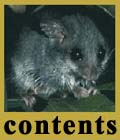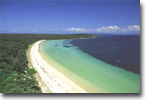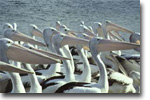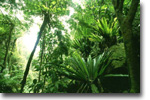
• welcome |
places of interest
Summer holidays are the perfect time to become acquainted with beautiful Jervis Bay. |
| Altogether, 12 places are individually listed in the Register of the National Estate (the national heritage inventory compiled by the Australian Heritage Commission), while the entire bay, an area of approximately 30,000 hectares has recently been included on the Register of the National Estate. If you are interested in natural history or discovering more about the fascinating story of human occupation of this part of the coastline, there are several local authorities and organisations happy to provide information. These include the Shoalhaven City Council, the NSW National Parks and Wildlife Service and ANCA. |
| JERVIS BAY AND SURROUNDS This listing includes the waters of the bay, the two headlands (Beecroft Peninsula and the northern part of Bherwerre Peninsula), a narrow strip of the offshore continental shelf and a belt of land around the bay, including several townships. This region contains a great diversity of landscapes, ranging from beaches, lakes, estuaries and cliffs to the forested slopes and heath-covered plateaux. |
 |
Landform The bay was formed by down-folding of the earth’s crust. This is in contrast to other bays of comparable size in eastern Australian which were formed by the flooding of river valleys. |
| European history Captain James Cook sighted the Bay in 1770 and named St Georges Head and Longnose Point. The township of Huskisson is noted for its shipbuilding history. The early pastoral settlement over the region reflects an important phase in Australian history. |
Images ©
Continue..




